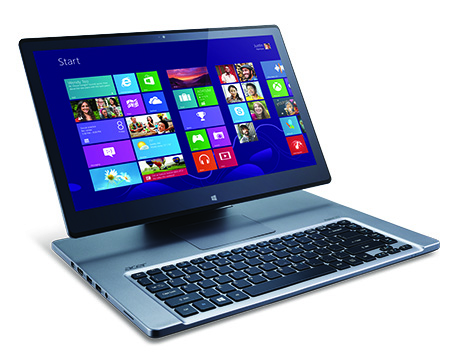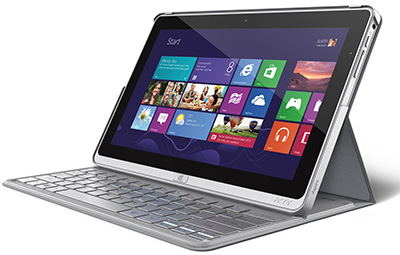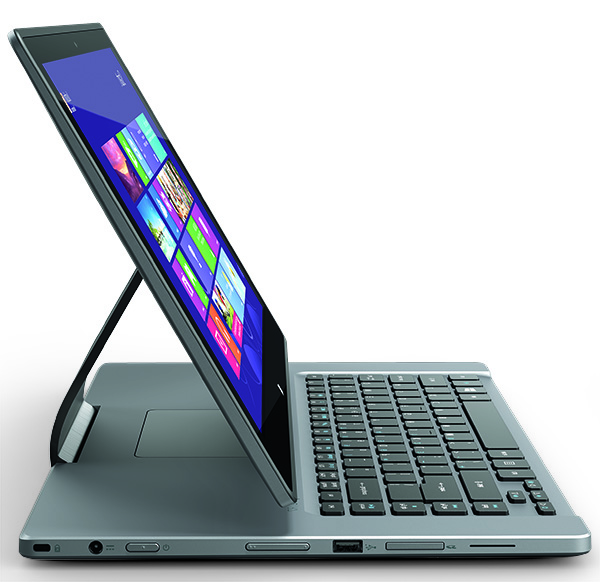Windows 8 hasn’t spurred a boom in PC sales, but it certainly is inspiring some unusual hardware designs. The problem, though, is that no one seems able to quite master Windows’ touch and keyboard-plus-mouse dual personality.
Acer is the latest to try with the Aspire R7, a striking departure from a company not particularly know for adventurous design. Aimed at what the company calls the “duality of touch and typing,” the R7 is a convertible 15.6″ notebook with a unique “Ezel” hinge that allows the screen to move from a conventional laptop position to horizontal to reversed (for presentations.) It also can lie flat in a slate configuration, but at 5.3 lb. (2.4 kg) it’s unlikely to see a lot of tablet use.
I can see uses for both the horizontal and the reversed positions. It’s the more conventional arrangement that is, in fact, the oddest. The most strikingly unconventional thing about the R7 is the layout of the keyboard deck. The keyboard itself is placed at the very front of the deck, with a large touchpad above it. Yes, you read that correctly. The touchpad is above to top row of keys.
 The display can be set up in two positions. In one (photo top), the bottom end of the screen sits just above the top of the keyboard, covering the touchpad and looking a bit like a gigantic version of an iPad sitting in a keyboard case. In the other (photo left), the screen opens like a conventional clamshell. I spent a little time using the R7 in both configurations. The screen-forward setup is more convenient for touchscreen use since the display is closer to your hand position on the keys. But in my experience with Windows 8 so far, the limited availability and frequently poor quality of “Modern” (or Metro) apps means I spend most of my time using legacy desktop applications, And since these are not built for touch, they generally don’t work very well without a mouse or touchpad.
The display can be set up in two positions. In one (photo top), the bottom end of the screen sits just above the top of the keyboard, covering the touchpad and looking a bit like a gigantic version of an iPad sitting in a keyboard case. In the other (photo left), the screen opens like a conventional clamshell. I spent a little time using the R7 in both configurations. The screen-forward setup is more convenient for touchscreen use since the display is closer to your hand position on the keys. But in my experience with Windows 8 so far, the limited availability and frequently poor quality of “Modern” (or Metro) apps means I spend most of my time using legacy desktop applications, And since these are not built for touch, they generally don’t work very well without a mouse or touchpad.
In alternative setup, the strange location of the touchpad is a real problem. When I am working in a typing application, I typically use my thumbs for most simple touchpad maneuvers, which lets me control the mouse without moving my hands from the keyboard. There’s no similar simple stretch available to reach the R7 touchpad. Furthermore, most of us now have 15 years practice with below-the-keyboard pointing devices and will spend a lot of time on the R7 poking at empty space. I hope to spend some more time with the R7 soon; perhaps the discomfort of using that oddly placed touchpad will go away quickly.
Microsoft could make this problem mostly go away by fully touch enabling Windows and key Windows applications. Maybe the Windows Blue update due in the fall will help, but there are depressing reports that a fully touch-ready Office won’t arrive until the fall of 2014.
 The Acer Aspire P3 takes a different approach to the duality problem. Though billed as a convertible Ultrabook, its design is much more like a Microsoft Surface Pro, a Core i5-powered tablet with a detachable Bluetooth keyboard. But in a sad concession to reality, it offers one thing the Surface doesn’t: A built-in stylus holder on the tablet.
The Acer Aspire P3 takes a different approach to the duality problem. Though billed as a convertible Ultrabook, its design is much more like a Microsoft Surface Pro, a Core i5-powered tablet with a detachable Bluetooth keyboard. But in a sad concession to reality, it offers one thing the Surface doesn’t: A built-in stylus holder on the tablet.

